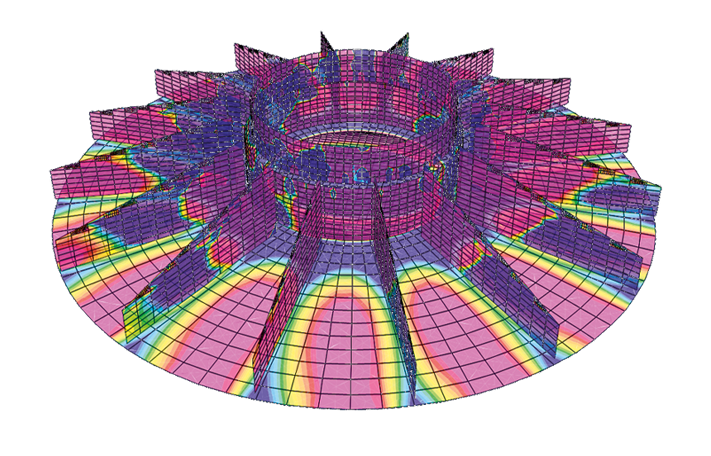Design and certification of wind turbines foundations
Timeline
2015-2023Sector
Wind energy: civil EngineeringScope
Design and certification of wind turbines foundationsBACKGROUND
For the construction of a wind park as well as for the selling of new foundation technologies, a design is required and on certain occasions, the design of the foundation to be used must be certified. In recent years, SOLUTE has carried out many foundation projects; an experience that has given us a reputation for creating solid designs as well as credibility in terms of the certification process.
The method for calculating foundations has been actively developed, which allows conducting a stability and structural analysis of the basic as well as special elements, within the deadlines prescribed by the industry.
SOLUTE has a civil engineering team specialised in structural calculation with extensive experience in the designing of wind turbine foundations. The portfolio of jobs carried out by SOLUTE includes surface slab type foundations with bolted cage or steel shell, rib foundations and also prefabricated and piloted solutions.
In terms of the certification of foundations, SOLUTE has developed a method for obtaining certifications that has been agreed to in each case, with both the customer as well as the certifying body. This way, a wide range of processes and standard documents are available, that may serve useful for streamlining the certification process, allowing us to complete the process within the established deadlines.
This way we are able to satisfy the two requests that are made by the customer. On the one hand, a foundation design that is valid and efficient, and on the other hand, the obtaining of a certification that is a guarantee when it comes time to offer the designs to third parties.
RESULTS
Optimum definition of all the foundation elements through the documentation and appropriate drawings, in a manner that allows obtaining the certification from the accredited body.
EXPERIENCE
The main customers interested in these types of studies are construction companies that have purchased wind turbine technology and need support in terms of defining the foundations, or small engineering firms that have developed new types of foundations and need to obtain a certification that will give them more visibility on the market.
In both cases, SOLUTE has recently carried out projects in which the foundation for the construction of wind turbines or its certification has been defined in due time and meeting the deadline.
The work tools that are used will primarily be FEM software calculation models such as SAP2000 (CSI) as well as sectional calculation software FAGUS (CUBUS).
METHODOLOGY
The foundation analysis carried out by SOLUTE is based on the industry standard regulation for wind turbines and structural calculation, both national as well as international. The main standards used in the certification process are:
• GL Guideline for the Certification of Wind Turbines, Edition 2010
• IEC 61400-1 Ed.3. Design requirements.
• IEC 61400-22. Conformity testing and certification
• Eurocodes: EN1990, EN1992 and EN 1997
• DNVGL-ST-0126
• EHE08
• CEB-FIP Model Code 1990
• Guidelines for foundations in road constructions. General Directorate of Highways attached to the Ministry of Development. Government of Spain.
• Guidelines for Design of Wind Turbines. Second edition - DNV/Risø.
Regarding the post-processing of the results of the modelling and data processing, we have developed our own tools in Microsoft Excel.
The methodology followed in the foundation calculation process is focused on checking the overall operation of the structure and defining the specific elements to ensure this behaviour is real.
This methodology includes the stability assessment of the structure, taking into account the conditions of the ground and the loads generated by the wind turbine; ultimate limit state, service and fatigue analysis of the general elements of the structure as well as the definition and structural analysis of the special elements the foundation may have, including the connection to the wind turbine tower.
Likewise, the system entails drafting documentation based on the requirements set by the certifying body, mainly comprised of documents that back up the calculations that are made and drawings with the definition of the geometry, armature and other elements that may be present in the structure.
Regarding the study of existing foundations where some type of defect has been detected or which want to be modified (checking of bolts under new loads, concrete cracking analysis, etc.), the procedure that is followed is focused on simulating the existing conditions (geometry, loads and geotechnics) using FEM models in order to subsequently post-process the results and carry out an assessment of the reinforcement, concrete sections and checks related with the connection (bolt cage, shell or post-tensioned tendons).
Based on the needs of the customer, support is provided after the drawings have been supplied, through adaptations of the solution and any possible modifications on site.
Wind
Measurement campaigns management
Design and management of weather measurements for renewable energy plants; wind as well as solar.
Solar
Solar resource
Realistic definition, with the minimum uncertainty, of the solar resource available in an area, to calculate the photovoltaic production of a plant.
